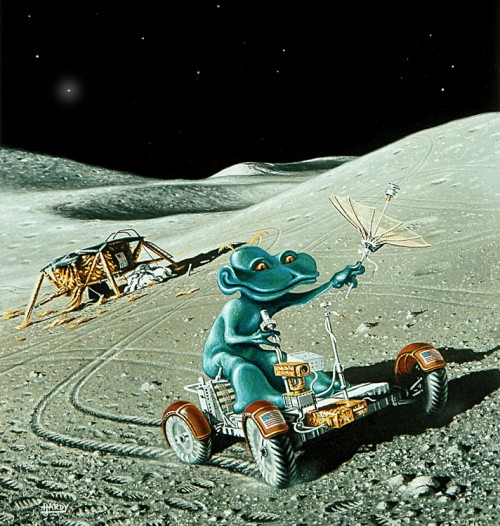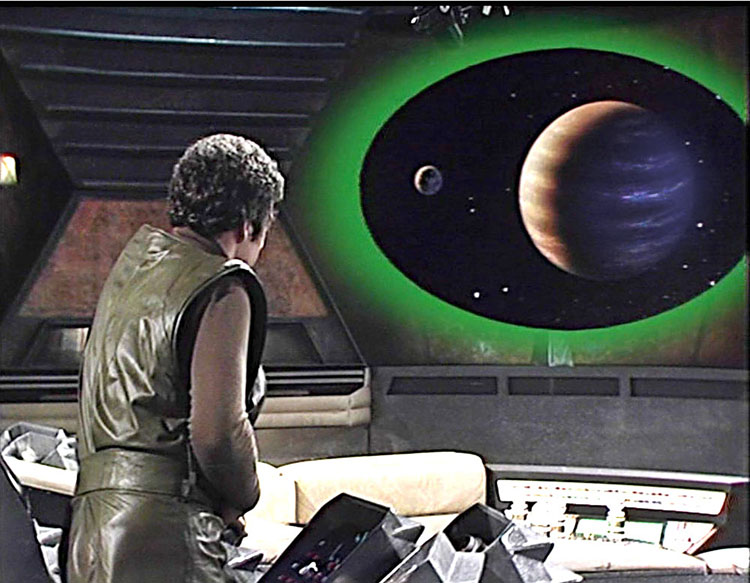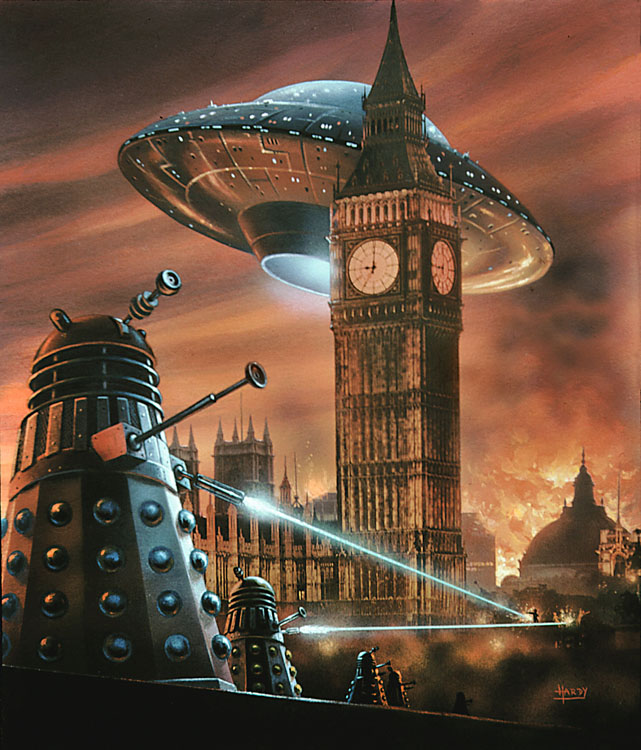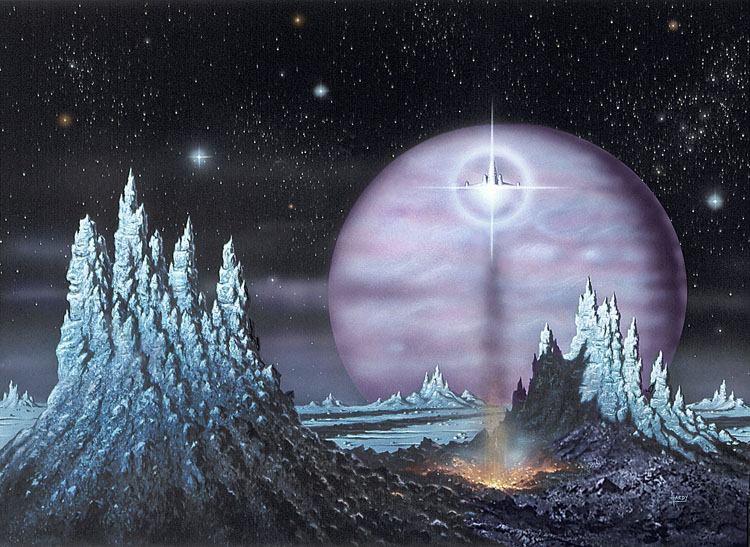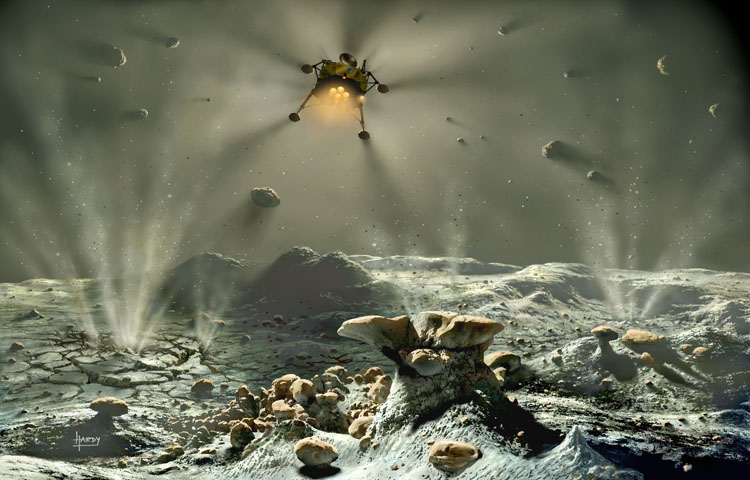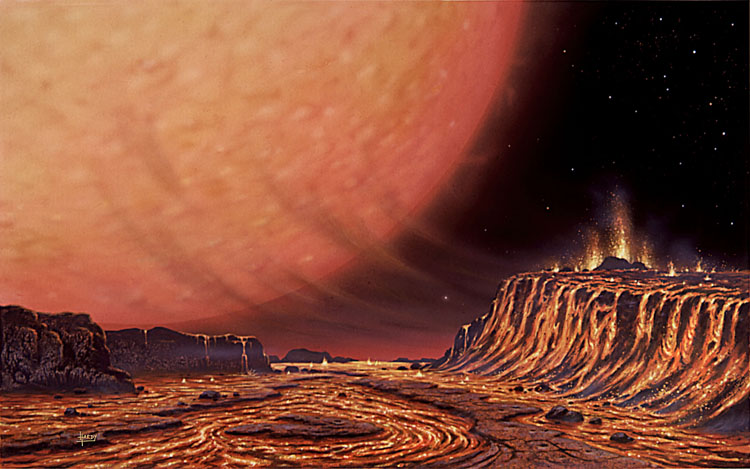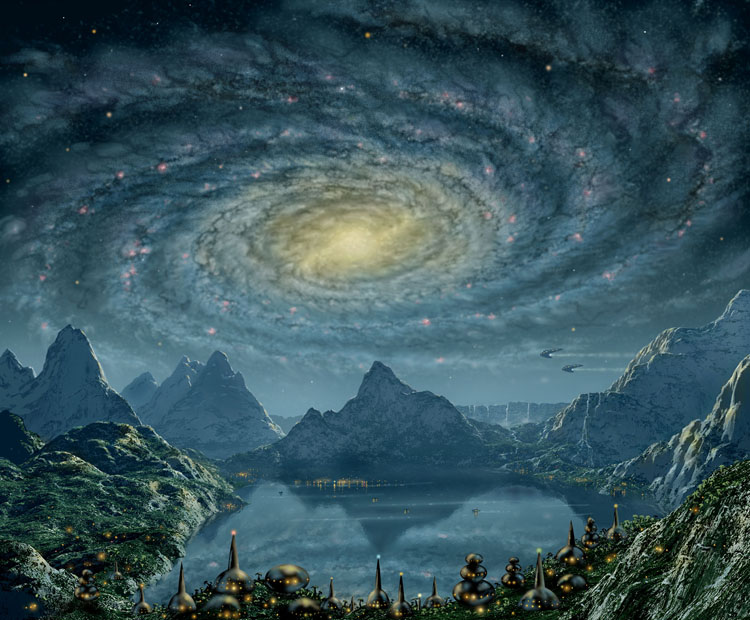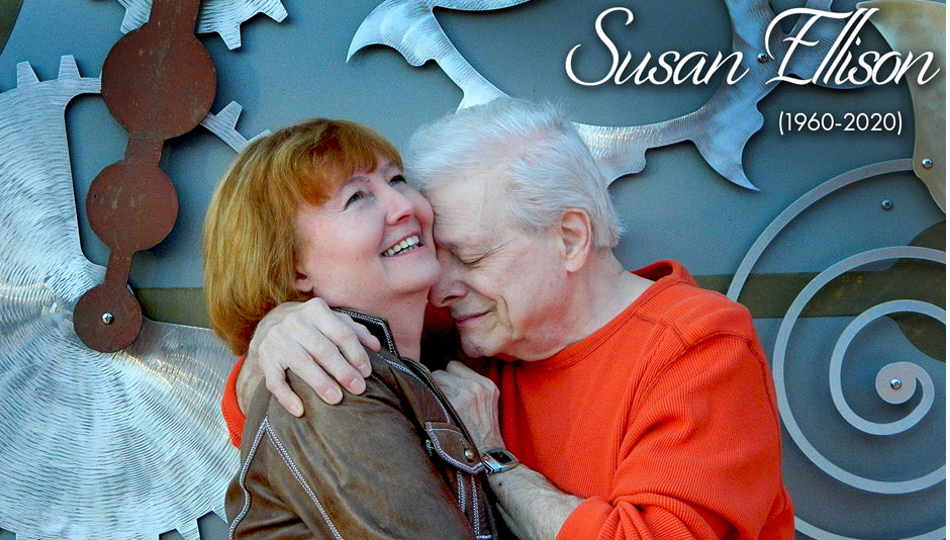In case the cover of this month’s issue looks familiar it is because it is a slight re-working of a cover that David A. Hardy – the subject of this present art retrospective – prepared for the Magazine of Fantasy and Science Fiction, the 60th anniversary issue of that iconic magazine to be exact (Oct/Nov 2009).

Mr. Hardy’s artwork gracing the cover of F&SF’s 60th birthday is unsurprising considering the large body of his work that had already appeared there. Anyone familiar with that magazine will be familiar with Hardy whether they know it or not, including his whimsical space alien Bhen.
Bhen was co-designed with cartoonist friend Anthony Naylor and was first featured on the cover of F&SF in 1975. He was frequently seen putting NASA hardware to unorthodox uses on nearly a dozen covers between 1975 and 1994.
But let us back up for a moment to earlier days, days filled with dreams of space and promise.
Towards the end of WWII an architectural illustrator and matte painter named Chesley Bonestell had begun selling his illustrations of space to a number of popular magazines such as Life and Coronet. Bonestell’s work was so scientifically accurate and offered readers visions of worlds they were just becoming familiar with that were so breathtakingly inspiring, that he eventually began working with real rocket scientists such as Willy Ley and Werner von Braun, illustrating their projects, plans and ships, making them real for a public that was just beginning to think of space as a place they could go.
In 1949, Ley and Bonestell published The Conquest of Space (a book that should be familiar to any baby-boomer). Bonestell’s illustrations were so realistic and convincing, Ley’s presentation so straight-forward and seemingly pedestrian that it helped to launch the popularization of space exploration. (With many of us wondering why we couldn’t leave tomorrow!)
The timing couldn’t have been more perfect for an English lad named David A. Hardy, who was at that “golden age of science fiction” – or just about ten, or eleven, or twelve. That age when we are still able to accept that there is wonder in the world and old enough to be able to appreciate it.
David was inspired by Bonestell’s work and would begin illustrating shortly after being exposed to it. In 1954, he landed his first book, illustrating Suns, Myths & Men by the english astronomer Sir Patrick Moore. He was 18 at the time, beginning a long and successful career that continues to this day. It was a relationship that would continue to endure to this day; David still appears on Sir Patrick Moore’s BBC television show The Sky At Night.
David strives for astronomical accuracy in his work, consulting all of the latest reports and findings and working them into his illustrations. In 1952, when David was 15, there were no rocketships, no space probes, no space telescopes. What little was known about the Moon and other planets was restricted to ground-based astronomy. Nevertheless, David turned out this illustration of a Moon landing for a proposed British Interplanetary Society project:
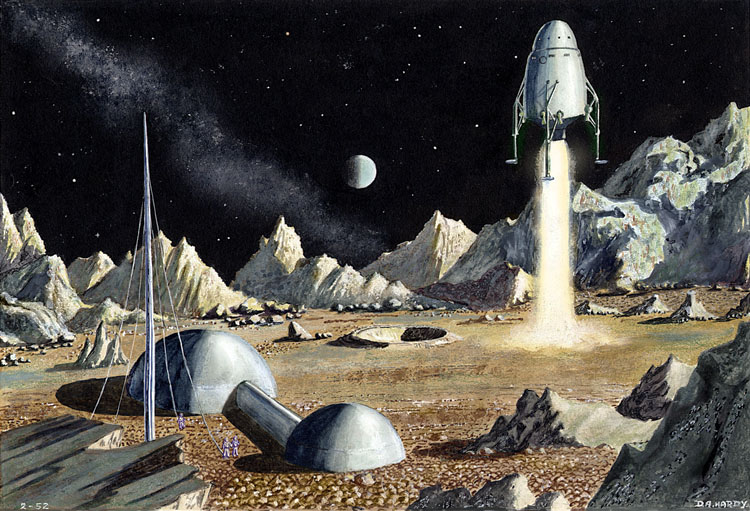
The lander is stunningly LEM-like for its time; it would be nearly another 6 years before Sputnick would beep around the world, 17 before Apollo 11. This is also David’s first published work, appearing in a local newspaper along with the title “David Has Some High Ideas.”

David’s work on Suns, Myths & Men provided him with stellar (pun intended) credentials: Sir Patrick Moore was and remains the UK’s most prominent space popularizer. David would go on to work on several other titles with him over the years, including Fifty Years in Space (2006), New Challenge of the Stars, Mars The Red World, helping to establish him as a go-to artist for scientifically accurate depictions of space.
David would later become a member of the International Association of Astronomical Artists, serving as its President in 1996 and receiving the Lucien Rudaux Memorial Award from that body in 2002. Today he remains a Fellow of the association and serves as its European Vice President.
Illustrating space is not without other-worldly rewards either: In 2003, the asteroid 1998 SB32 was officially renamed for the artist – asteroid Davidhardy.
During the years intervening between his start in 1954 and today’s illustration of Amazing Stories’ cover in 2012, David has traveled around the globe numerous times. (indulging his passion for volcanoes among other things); his work was favored by Amazing Stories alumni including Isaac Asimov and Arthur C. Clarke (he supposedly just missed out on an opportunity to illustrate the Clarke/Kubrick collaboration 2001: A Space Odyssey) and Carl Sagan among others. He is also currently a VP of the Association of Science Fiction and Fantasy Artists and has been nominated for their Chesley Award numerous times; has received the Best Cover Art Reader’s Award from Analog magazine, been nominated for the Best Artist Hugo Award, and has received both the Sir Arthur C. Clarke award for Best Written Presentation and the Best European SF Artist award.
David A. Hardy is, in fact, the King of Space Art, having been at it longer than any other artist currently practicing in the field, and it is easy to see why.
I think it important to express how critical the artist is to both the scientific exploration of space as well as to science fiction. Human beings, it is said, are visually oriented creatures. We can’t really gain a true understanding of something until we’ve seen it with our own eyes – which presents problems for trying to understand things we can’t see or that don’t yet exist. This is where artists like Hardy enter the picture.
No one knew what the Moon really looked like down on the surface until artists like David began illustrating it for us, and then we all wanted to go. And of course most of science fiction is concerned with things that are not yet of this world; authors can be extremely effective in conveying images, but as they say a picture is worth a thousand words.
David is keen to express the difference between the two disciplines, as he did during this interview with UniverseToday earlier this year:
I do feel that it’s quite important for people to understand the difference between astronomical or space art, and SF (‘sci-fi’) or fantasy art. The latter can use a lot more imagination, but often contains very little science — and often gets it quite wrong. I also produce a lot of SF work, which can be seen on my site, and have done around 70 covers for ‘The Magazine of Fantasy & Science Fiction’ since 1971, and many for ‘Analog’. I’m Vice President of the Association of Science Fiction & Fantasy Artists (ASFA; www.asfa-art.org ) too. But I always make sure that my science is right! I would also like to see space art more widely accepted in art galleries, and in the Art world in general; we do tend to feel marginalised.
Examples of the attention to detail – and his ability to imagine the non-existent – are amply illustrated here.
After serving in the RAF (during which time he continued to illustrate), David did a stint as a commercial artist for Cadbury, the candy company and then struck out on his own in 1965.
Since that time David has provided illustrations for televisions shows – including Blakes 7
A UK based show. David was asked to illustrate the planets that would appear in the background and through ship portals during the show’s second season.
He has also been asked to illustrate some of science fiction’s most iconic images, including Dr. Who and the Daleks.
This image showing Westminster and the invaders was created for Dr Who: The Dalek Invasion of Earth by Terrance Dicks. Why the Daleks choose to invade at 3 is something you’ll have to ask David.
David is capable of humor as well, as illustrated by this faux SF magazine:

that graced the cover of a CD from the British National Space Center. (The ‘spoof’ was that while it looked like a pulp magazine, the contents was all serious science).
David’s work has also been admired (and purchased) by members of the rock community, including The Rolling Stones and Queen. He was originally asked to illustrate Jeff Wayne’s musical version of the Well’s story and produced what has become one of his most recognizable pieces – Martian Tripods attacking the HMS Thunderchild. (In the novel, the ship sacrificed itself while successfully protecting civilians who were escaping London.)
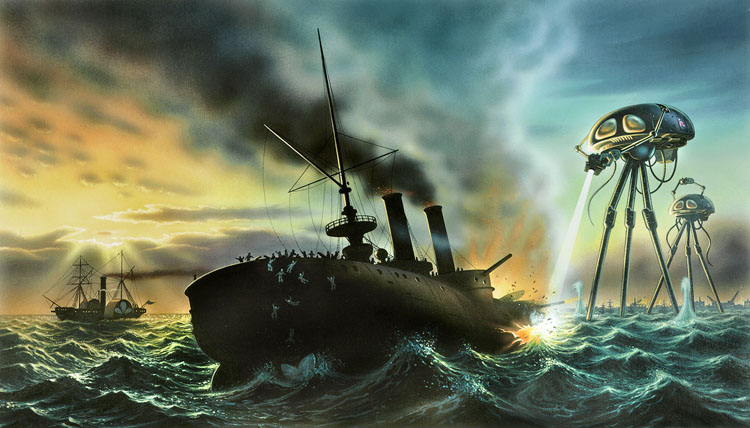
I have to admit that this is certainly one of my personal favorites. Until the advent of this picture, I considered Frank R. Paul’s illustration of a similar scene on the cover of Amazing Stories to be the best I’d seen for Wells’ novel. Now I just put them side-by-side and don’t bother trying to pick one over the other:
Paul’s illustration is frenetic, over the top and mechanical. Hardy’s (benefiting from several decades of intervening knowledge) shows us a smoother blending of the real and the fantastic, as do these other pieces:
Lift Off, a frequently reproduced illustration, is the perfect evocation of science fiction’s sensawunda: where is this? what was the ship doing there? why is it leaving now? where is it going? We’ll never know the answers, but that’s at least half the fun.
The following mission has not happened yet, but this illustration – Comet Probe – occupies the middle ground in David’s work, straddling the divide between fantasy and reality.
Several years ago it was discovered that Io (one of Jupiter’s Galilean satellites) was an active planet; several planetary probes caught “ice geysers” in profile against the planet’s rim. We learned that such things happened for real, but it took David Hardy to give us a much better idea of what it would look like from ground zero:
It also takes an artist to show us what the future holds for our solar system –
and to give us some idea of where we may go someday:
All of the illustrations here were generously provided by David for this article; he even touched up the graphic that heads up the excerpt to his story Aurora that appears elsewhere in this issue.
David A. Hardy has recently revamped his website and offers prints of nearly all of his works (for extremely reasonable and affordable prices). That site can be seen here – AstroArt.
There are also several interviews and gallery displays of Mr. Hardy’s work on the web, including:
a biography on SS3F
a 2004 interview on UniverseToday
a more recent interview and gallery on the same site
a gallery at Outer Space Art Gallery
and a small gallery and prints on Nova Space Art
I hope you all enjoyed this trip through David’s work and choose to pay him a visit on his website.

